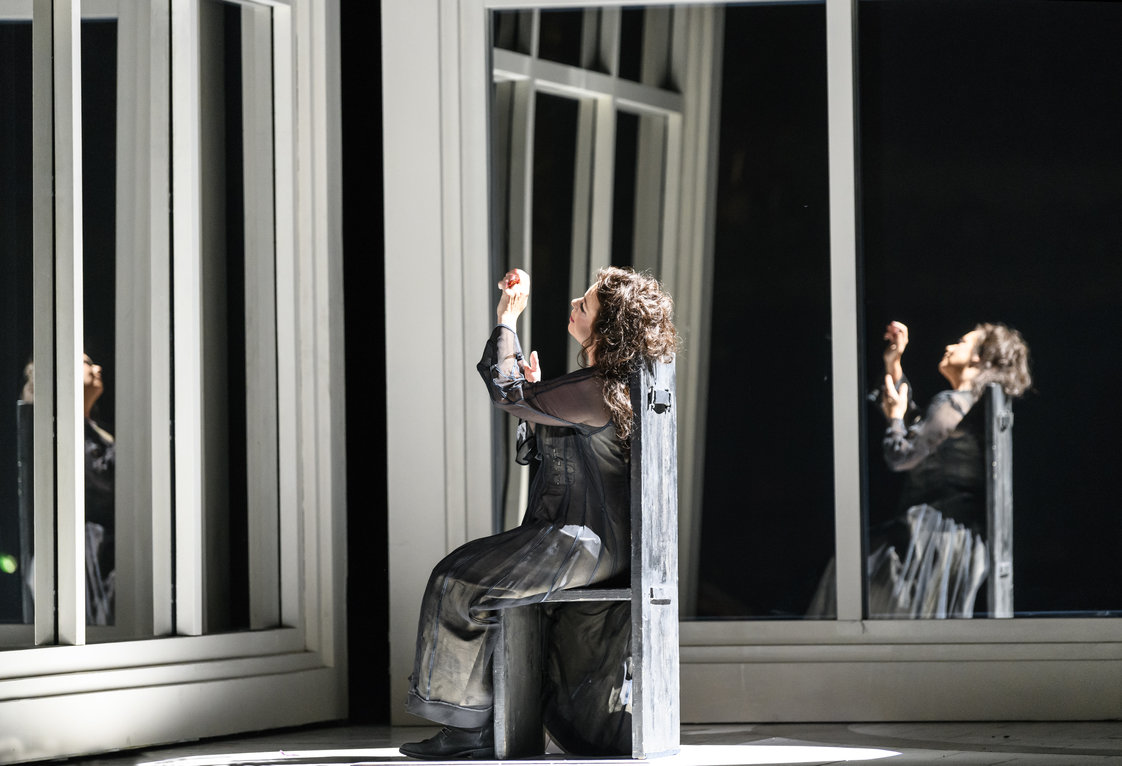And so it ends. Flames give way to water, and as the Rhinemaidens resume their naked dance we come full circle – quite literally in Keith Warner’s Wagner Ring – back where we began, on the banks of the Rhine. Once again we find ourselves on the brink – but of what? A young woman framed in the giant ring that descends in the music’s final moments suggests a hopeful new beginning, a new generation of heroes. But with the old gods burnt up in the fire, who or what will take their place?
Third time round, and still things remain – for good or ill – ambiguous in Warner’s staging. Admittedly in Götterdämmerung the clutter does begin to clear. Symbols painstakingly loaded with meaning over the previous three evenings seem to shake themselves free, and we move from something close to allegory to a free flow of images and ideas. There’s an exhilaration about it, a playfulness almost, as Warner and his characters seem to dance on the brink of the abyss.
Vocally both Stemme and Vinke romp home
The visual punchline of the Gibichung Hall – revealed in Stefanos Lazaridis’ design as a giant twin of the Tarnhelm, all mirrored panels and sleek illusion – still hits hard and accurately, and the giddy, eagle-eye view of Siegfried’s journey down the river, travelling not just through space but time, as huts give way to tower blocks and cities, is a moment of pure visual pleasure among some rather austere stage pictures.
Things take a more sinister turn with Gunther’s kinsmen (pictured below, the first appearance in the cycle for the Royal Opera Chorus – putting all their considerable power into this short episode). With The Handmaid’s Tale freshly in mind, the bonnets and aprons of the cringing women, and shiny black helmets of the men who cluster like a well-funded mob around Brünnhilde, seem more oppressive than ever – just the better-dressed cousins of the slaves down in Nibelheim. But in this final instalment, where focus finally shifts from objects to people (I do wonder just how much of the fiddly, prop-centric activity in the earlier instalments is clear from the amphitheatre), it’s the cast that make or break. After the ardent first flushes of love in Siegfried (thrillingly rendered here, by all accounts) it’s here that we get down to the everyday business of a relationship. There are some telling details in Brünnhilde (Nina Stemme) and Siegfried’s (Stefan Vinke) negotiations, her insistent affection, his obliviousness – eyes already onto the next adventure. It’s a brief but crucial moment of vulnerability for Stemme before we see her steel herself for vengeance and self-sacrifice, a flash of flesh under the impenetrable armour.
But in this final instalment, where focus finally shifts from objects to people (I do wonder just how much of the fiddly, prop-centric activity in the earlier instalments is clear from the amphitheatre), it’s the cast that make or break. After the ardent first flushes of love in Siegfried (thrillingly rendered here, by all accounts) it’s here that we get down to the everyday business of a relationship. There are some telling details in Brünnhilde (Nina Stemme) and Siegfried’s (Stefan Vinke) negotiations, her insistent affection, his obliviousness – eyes already onto the next adventure. It’s a brief but crucial moment of vulnerability for Stemme before we see her steel herself for vengeance and self-sacrifice, a flash of flesh under the impenetrable armour.
Vocally both Stemme (pictured below) and Vinke romp home, he in the startling freshness of his final tale of childhood, she in an Immolation Scene of rapturous intensity. But it’s Stephen Milling’s Hagen that unlocks this uncertain conclusion. With a voice and face that could have been carved out of an Old Testament rock, the Danish bass holds the fate strings in his enormous hands, twitching his puppets with infinite skill. Only in dealings with Emily Magee’s vocally voluptuous Gutrune does he betray himself, otherwise unreadable and impenetrable, staring out into the audience, daring us to pity him. The cameos keep coming as all the Norns’ narrative threads get tidily wound up. Rhinemaidens Lauren Fagan, Angela Simkin and Rachael Lloyd (stepping seamlessly in for an indisposed Christina Bock) trickle and glint in their radiant trios. Karen Cargill’s Waltraute is granite to Stemme’s mahogany, and Markus Butter’s Gunther is all brittle authority and ambition as Gunther. After some squalls on previous nights, Pappano’s brass galvanise themselves for a glowing conflagration, and percussion offer horrible clarity in Siegfried’s funeral march.
The cameos keep coming as all the Norns’ narrative threads get tidily wound up. Rhinemaidens Lauren Fagan, Angela Simkin and Rachael Lloyd (stepping seamlessly in for an indisposed Christina Bock) trickle and glint in their radiant trios. Karen Cargill’s Waltraute is granite to Stemme’s mahogany, and Markus Butter’s Gunther is all brittle authority and ambition as Gunther. After some squalls on previous nights, Pappano’s brass galvanise themselves for a glowing conflagration, and percussion offer horrible clarity in Siegfried’s funeral march.
It’s the only real clarity we do get by the end of Warner’s cycle. Against so much splendour, power and spectacle, can we really trust the fragile promise of that single figure, perched precariously above the ground? In interviews Warner has spoken about turning the focus outwards here, asking the audience to take up the story. But we didn’t need to go to the theatre to find ourselves at a crossroads while behind us the world burns.














